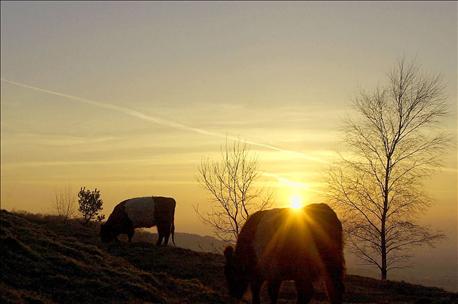
I’m not sure what city people converse about, but as a veterinarian, health and nutrition topics and concerns get considerable playtime, but weather is numero uno. For years I was of the opinion that we did not have any control of the weather but as I have learned more about planned grazing, soil improvement, and animal health it has become possible to neutralize much of the negatives of the daily climatic conditions.
Cattle are most productive and comfortable at 20-30*F cooler than their owners. Haze and high humidity multiply the negative effects of the temperatures, either hot or cold. A little or a lot of wind has more than considerable effect on both sides of the scale.

This time of year attention to a range of details can keep cattle cool, and productive, during these dog days of August. (Photo: Dan Regan/Getty Images News)
Slick shiny animals with a good circulation and organ function get along better and keep grazing considerably longer than long haired dull dry coated, thick hided black cattle.
In our area we average less than 30 cold, wet, humid days and nights annually. During December, January, February, and March we will average 17 inches of actual moisture. This makes for freezing and thawing mud issues but keeping cattle cool spring, summer, and fall is a bigger issue. Most years I have noted in excess of 100 days and nights that were stressful. Anything over70*F with 50% humidity can set back some cattle. Summer temperatures over 70*F at daylight are our norm as is a relative humidity of 80% +. These are indicators of dangerous heat stress especially when repeated for 3 or more days.
How do we cool off cattle? Here is what we look for, plan to accomplish, and work to execute.
* Fescue and cool season forage control and plant maturity. Reduction of forage NPN (non protein nitrogen)
* Early spring hair shedding
* Lighter colored cattle
* Quality water
* Salt and mineral/trace mineral supplementation and readily available
* Very ample shade availability that is safe, clean, and not over abused
* Energy supplementation based on urine PH’s
* Forage diversification
* Vascular dilation
* Skin and hair coat monitoring
* Rumen microbe stimulation (soybean meal, etc.)
* Fiber digestion increasers (apple cider vinegar)
* Night grazing
Several years ago we started monitoring urine pH levels of our cattle on a regular basis.
PH is a measure of the hydrogen ion (energy). A pH of 6.8 is considered optimal. Lower pHs are acidic and higher pHs are alkaline. Our steers’ urine pHs’ were in the low 9s (very alkaline). This very alkaline pH indicates a low energy diet that is excessive in non-protein nitrogen (NPN). In our case the NPN in huge amounts was coming from the dense, wet pastures of the cool season plants and the very immature warm season plants we were growing and grazing. Forage energy levels were low due to lack of calcium base (limestone), high moisture, and absence of intense sunlight due to clouds and humidity.
Pastured cattle that are alkalotic cannot handle heat. The majority of the alkalosis is caused by the absorption of ammonia from the excess NPN through the wall of the rumen. Cattle are unable to excrete excessive ammonia thru the kidneys. Excess ammonia is very rough on tissue linings including the lungs. Cattle that do not breathe well can’t stay cool.
We opted to add energy supplement to the cattle in amounts of 2-3 lbs. of ground corn or 12 oz. of molasses daily per 550 lbs. of body weight. In 7-10 days the steers had cooled off and PHs were in the 7.5 range.
Stimulating and increasing vascular dilation and circulation has been practiced for centuries by cultures that live in “hot” environments as has long shaded rest periods during extremes of the day heat. Hot peppers have been an ever present part of the diet and are now being used in cattle to cool them off. One half tablespoon or more of cayenne pepper per 500 to 1000 lbs. of body weight cooled off several thousand feed yard steers in Kansas when temperatures and humidity got extreme and the wind stopped blowing for over 3 days.
I know that it is fall but if your winter planning is ready to execute and accomplish it might just be time to start thinking and planning for next year’s heat. I’ll add a few more thoughts in some blogs. Have a great fall and winter.
- Doc can be reached at 931-761-5001 or email [email protected] He offers economical telephone consultation service and small group intensive half day outside conferences on multiple ranch and pasture sites. Low input soil building, cattle production and health, and plant energy are his emphasis.
About the Author(s)
You May Also Like






